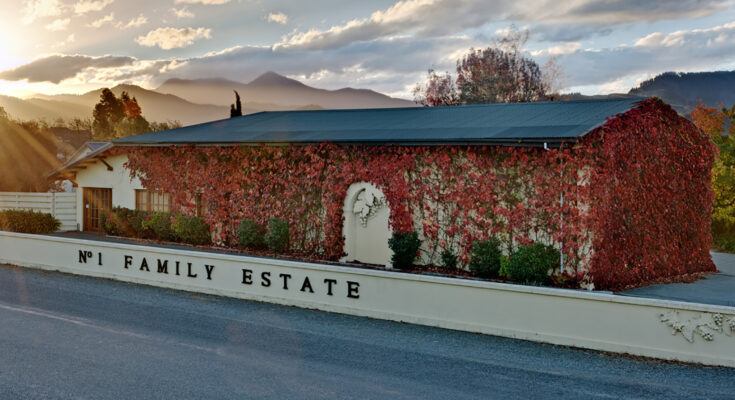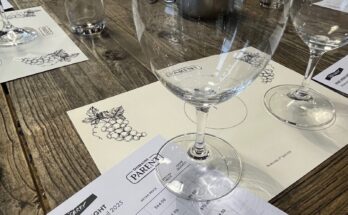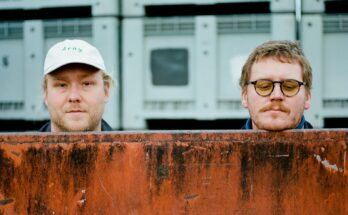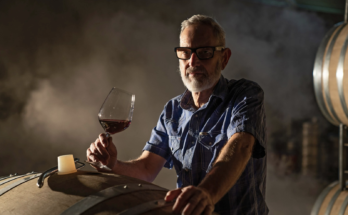I’d promised to call into No.1 Family Estate after a visit to Marlborough last year had not found time to drop in and talk to the team about their sensational Methode Traditionelle wine. They recently celebrated their 40th anniversary of making wines in Blenheim, although their roots of course go way back further – to the home of sparkling wine in the region of Champagne itself!
As I arrive I’m greeted at their glamorous Cellar Door with a glass of their No.1 Assemblé wine. It is blend of 65% Chardonnay, 35% Pinot Noir and 5% Pinot Meunier. Deep, rich and complex having spent 3 years on lees. It has a gorgeous toasted brioche autolysis flavour and is just stunning. This would normally be thought of as a wine to have in the sunshine, but I’m all for a winters evening – cold outside and with the fire going.
I’m also treated to the No.1 Rosé which is a delicate pale pink colour, having had almost no time on skins. It’s soft and smooth, delicate, with a little smokiness, and with a floral lift that’s all musk rose. This wine was, impressively, a big winner in the Champagne Sparkling Wine World Championships. Gold medal, Best in Class and National Trophy.
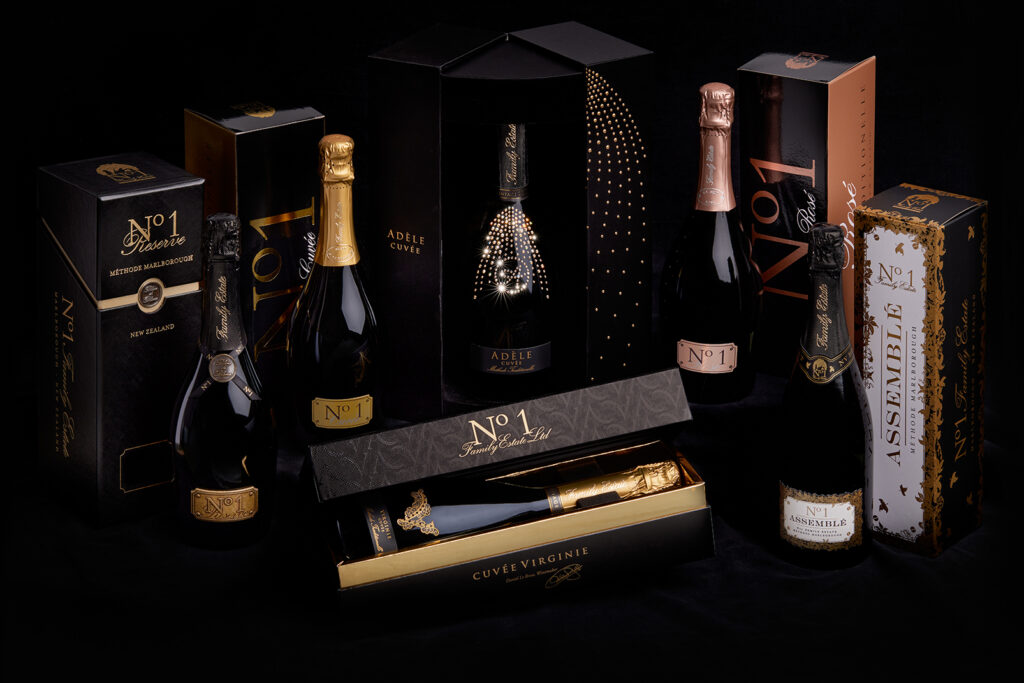
Virginie appears just as I spy a bottle I haven’t seen before and ask about it..
Virginie Le Brun: 70 calibre. That was a bit of a secret vintage for Papa’s 70th. It was made by Lee our Winemaker and Winery Manager, and Remy, my brother who is now Junior Winemaker. It was deliberately produced in the same bottle as the Assemblé so that we could quietly manage it, and Papa couldn’t see what it was. It was revealed at his 70th birthday and was a great surprise!
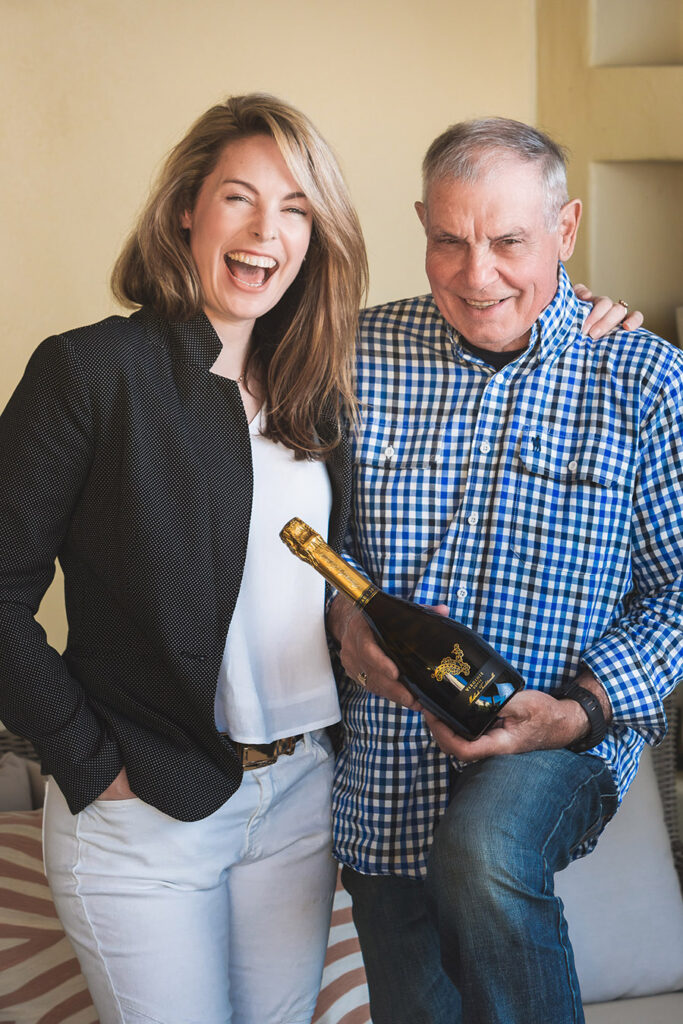
Also, Cuvée Virginie – 80% Chardonnay and 20% Pinot Noir, zero dosage, so Extra Brut style. The original one was for my 21st, then 2009 and 2016. Years ago when we had the very first Cuvée Adele for Mum’s 40th, I was just like “Papa… Papa… Papa…” He was not getting away without making a vintage for me. I started working on that very early. We all have our namesake Vintages which is pretty cool. The wording on the back of the Cuvée Virginie roughly translates as ‘dedicated to the well-deserved success of my little girl’ but that’s paraphrasing it as it doesn’t translate directly very well.
Would you like to have a look around the winery? The glamour unfortunately ends here and we’ll need to don the fluoro.
In the corner here – and I really shouldn’t love it as much as I do, but I really do love it, is our Champagne press. Much of the machinery we have here has come from Champagne but this one in particular I have a soft spot for. We brought this to Marlborough when I was very little – it arrived in 1984, so it’s just a few years younger than me. She’s been here a while. I brought a friend in here who was doing a vintage at the time for another winery and I said “and this is our press!!” she was like “wow, it’s really old”. I was horrified – this is like my little sister (laughs). To me this is a pretty important part of our family.
It’s a specialist Vaselin Press from Champagne, specifically for pressing grapes for Methode. Over the course of four hours, the steel plates will slowly come in towards each other, to very gently extract juice. We only take about 620 litres per tonne as it’s all about quality not quantity.
WineFolio: It’s great, it’s a real character isn’t it? That’s classic, I love that.
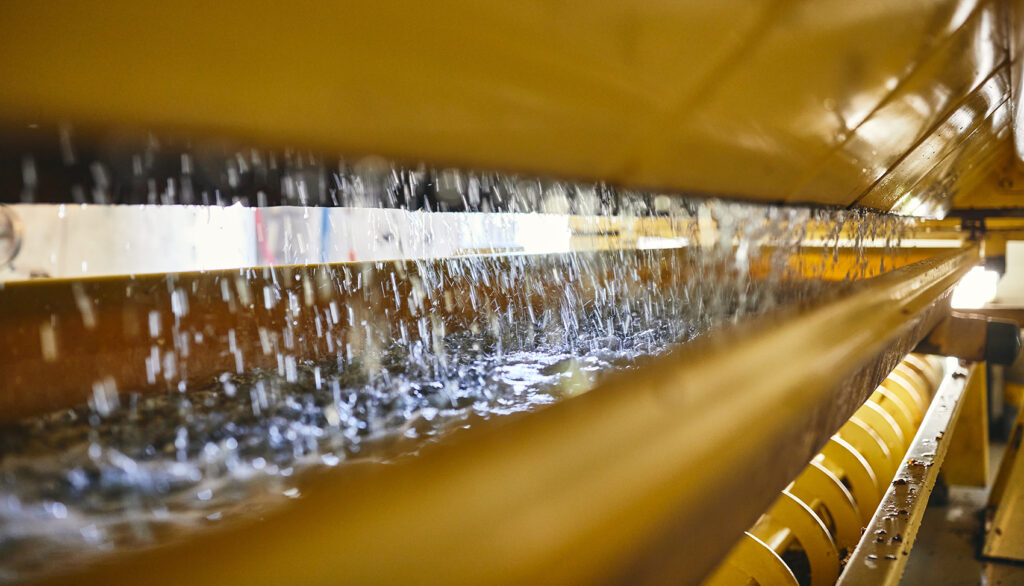
VLB: Like I say, everything comes from Champagne but this one is a little extra-special.
We take a look at the ‘gyro pallets’ – again, imported from France, and doing the job of ‘riddling’ the bottles – what was once painstakingly manual labour.
Although Virginie is quick to point out: “There’s still a great deal of manual labour goes into making méthode – sometimes there’s just no speedy way to do things. People often don’t realise that at all”.
We take a look at the disgorging line, which if you haven’t seen before is actually a really fascinating process. First the neck of the bottle is frozen to capture the lees in the form of an ice plug. The pressure in the bottle is around 90psi, so when opened, the plug is ejected under pressure. The dosage is added, cork inserted and held in place with capsule and muselet (wire cage), the bottle is shaken (to integrate dosage with the wine), washed and labelled all in the space of a couple of metres of technical, semi-robotic wizardry – supervised of course!
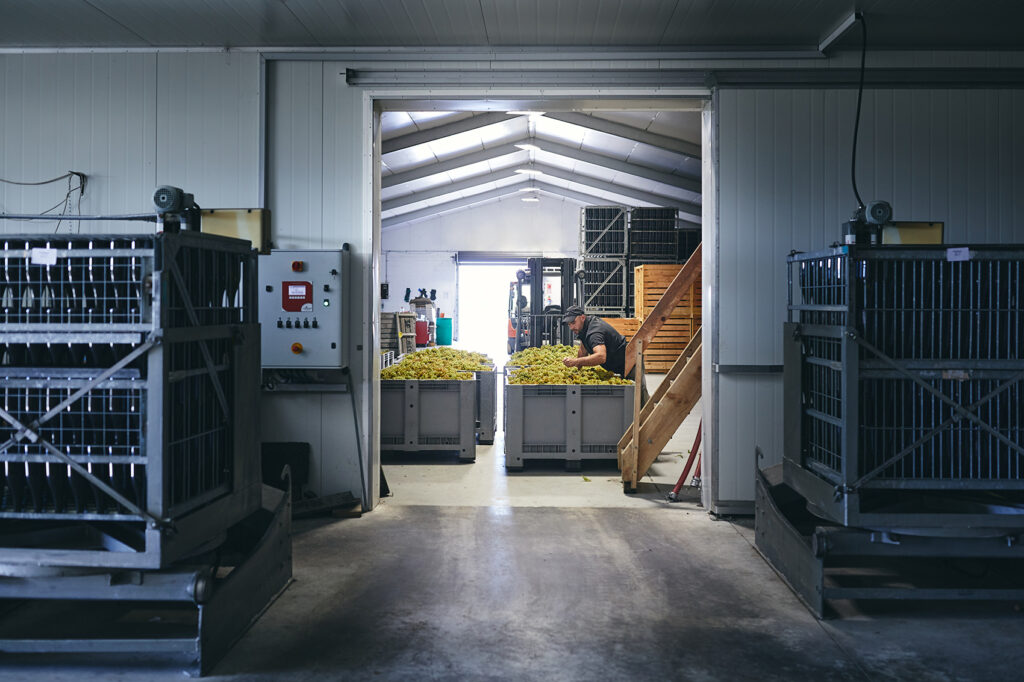
As we leave the noisily efficient business end behind and head back out, we stop and look at a tank that belonged to Virginie’s Great Grandfather Pépère Nestor, a 10th generation winemaker from Champagne. The taps have been changed, but it’s otherwise as it was when it was brought it over from France.
VLB: My aunt has just refurbished the old family press room in Champagne, where if you think that tank is old, I’ve a got a photo of a really old girl to show you! It looks beautiful – so, so cool. That lineage to our family is really important.
WF: Is that still a very active connection? Are there visits?
VLB: In a normal world, pre-COVID, Papa goes at least once a year. When I lived in the UK, I was there about once a quarter. Whilst we’re talking of family history let me show you the rings I am wearing – this one belonged to Pépère Nestor’s wife Mémère Louise, my Great Grandmother. It’s a gold franc coin and the Lady Liberte is so worn down because she wore it all the time. This rose gold band was my Great Great Grandmother’s, her name was Virginie. I also have a pendant handed down from my Great Grandmother Catherine (on mum’s side). This one is too fragile to wear. So I’m named after all three of them, Virginie Catherine Louise Le Brun.
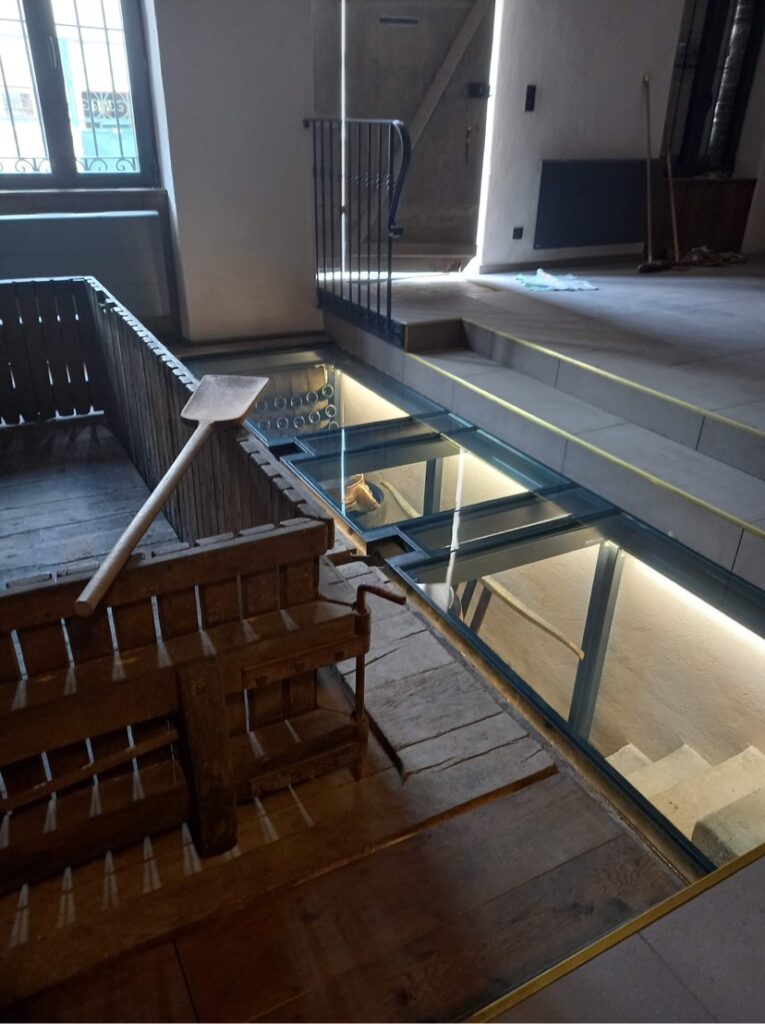
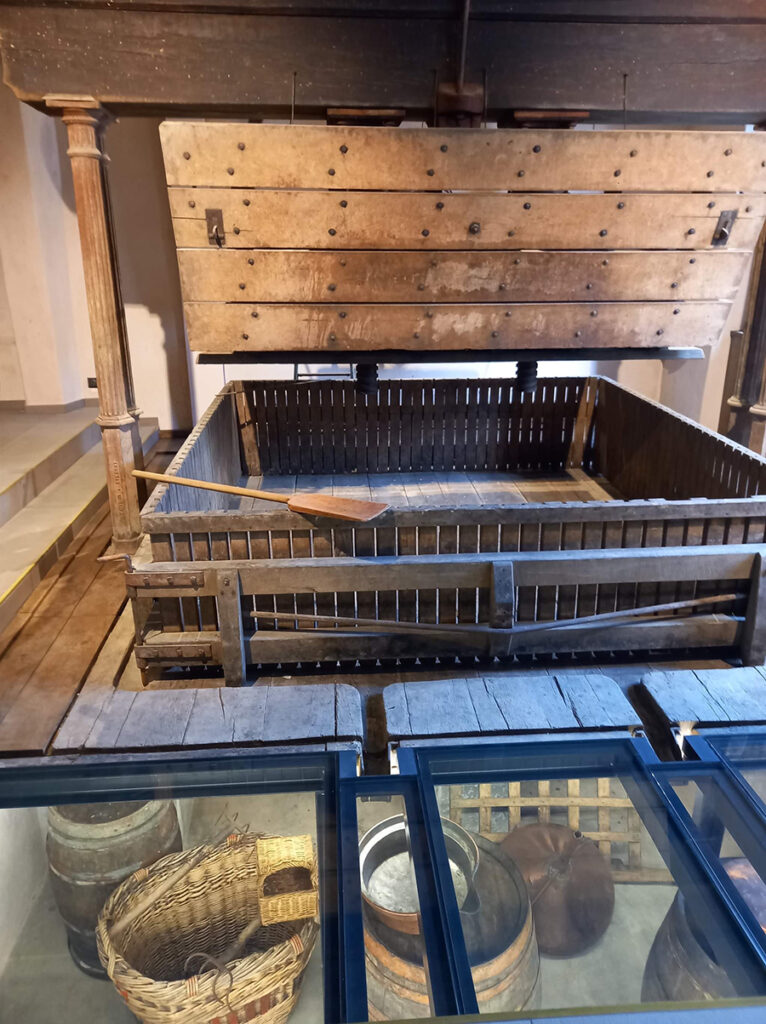
We only just got this photo last night and I wanted to show you. This is our old family press – the building was built around it, and it’s been in situ since 1791. My Aunty Isabelle has converted it into a B&B and it’s so exciting to see. The press used to have written, in chalk, above it – I think it was “1961, then the yield, and underneath that (in French) the year of the great wine”.
In the photo are these baskets; and you would get a rod and put it through the handles, one basket on each end, and two people would lift it up on their shoulders and walk it down from the hill to put it into the press – of course nothing is flat in Champagne – each full basket weighing about 90kg.
WF: And how long would one of your bottles be OK to drink – can you cellar them for years?
VLB: We have library stock right from the beginning of No.1 Family Estate, and even some from our Cellier Le Brun days (Mum and Papa’s first venture). Most is drinkable, of course the characteristics and profile change over time. I would say between 5 and 10 years pretty comfortably, providing it is kept correctly. For my own cellar and family consumption, I like to follow vintage charts. My preferred is Berry Brothers & Rudd. Although, in my opinion, it is a little too conservative when it comes to the ageing potential of New Zealand wines, especially sparkling which has the acidity to stand up to longer cellaring. I had a non-vintage magnum of No.1 that was lovely – still bubbly – more than ten years after I was given it.
WF: How important would you say that Champagne connection is to the No.1 Family Estate brand?
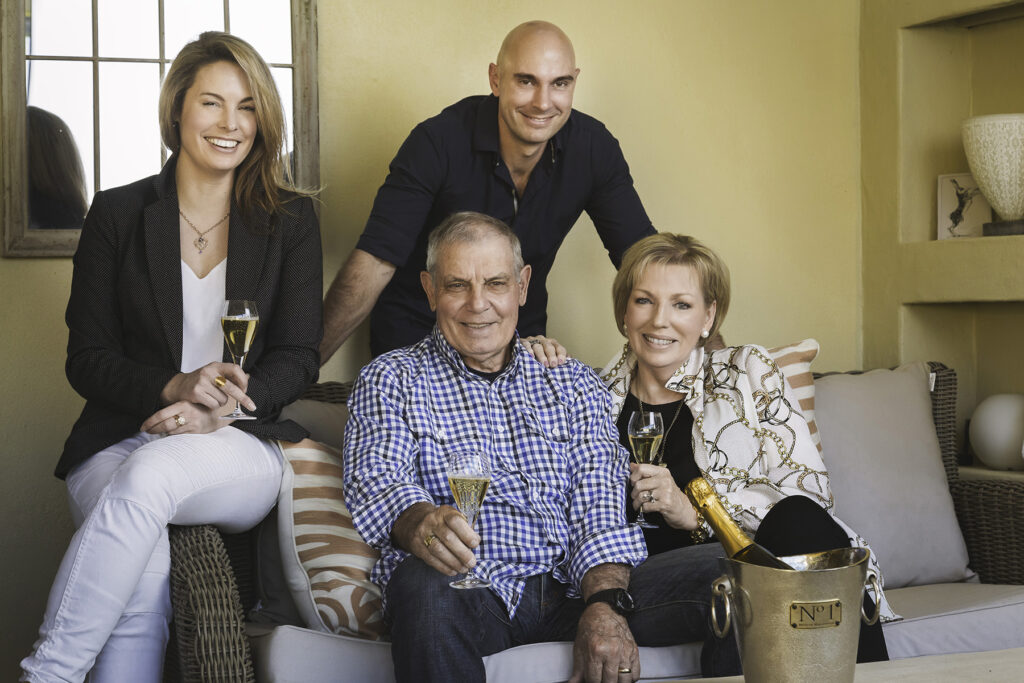
VLB: It’s all part of our individual stories, and you have your own connection to your own history. For me it’s very significant because it’s in our blood. 1684 was the first recording of the Le Bruns planting vines in Champagne. So it’s something that has run in our family for generations. There’s all kinds of twists and turns in the road that you think had something happened differently we wouldn’t be where we are today. One example is that Mum met Papa in Rotorua. She was from the north of England. He was from Champagne. She was working at the paper and she said to a friend “I’ve got a do tonight, but I need to take a bloke that’s got a suit – do you know anyone?” and her friend said “What about that Frenchman who’s flatting with such-and-such – he’ll have a suit” And he did, and it was Daniel. We were cleaning out the storage containers at the back of the winery the other day, and found the suit and I said to my brother Remy “Look at that… If it hadn’t been for that suit, you and I wouldn’t be here”.
My Great Grandfather Pépère Nestor, was a leader of the Resistance in our village, and we apparently had guns hidden in the attic. So if the Nazis had found that, everything would be different again. Throughout all this time we have produced wine. It’s so deeply ingrained in who we are and what our identity is. It was from Pépère Nestor that Papa really found his passion for wine. With Remy and I – we both had our respective careers before we came deeply into the family business. The last time my Grandfather Pépère Rene (Daniel’s father) visited New Zealand – he would have been about 93 at the time – he said to Remy “you need to come to Champagne and you need to see where it is that you are from”. So Remy went over and that was it – the penny dropped. He hadn’t been there since he was a kid. So that’s what changed Remy’s mind; and for Papa it was his Grandfather Pépère Nestor. Sometimes the connection skips a generation.
WF: Do you think there will ever be a time when the New Zealand version can sit on the same level as Champagne?
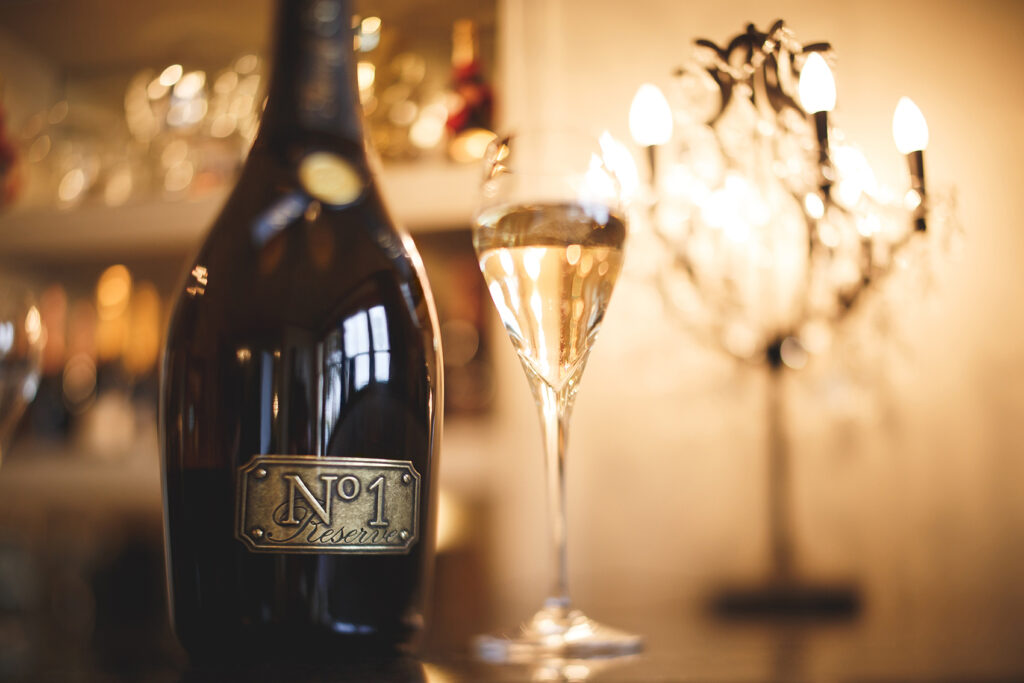
VLB: Absolutely. I think it’s possible. Arguably there’s no stronger brand on the planet than Champagne. It’s why they fight so hard to keep the parameters of that as tight as they are. Even to the point where Yves St Laurent did a perfume called Champagne, and the Appellation put a stop to it.
WF: I‘m really interested in the smell of things. When I was at college I had a flatmate doing some sort of chemistry course and she aimed to get into one of the big perfume houses and work in that industry. She would bring back all these little bottles of scents and I’d have to describe what I could smell in them. So, even now, if I get dragged around shops by my wife, I’m OK if the shop has some candles that I can stand and investigate. Shopkeepers probably think “who’s the old fella over there sniffing the candles..weirdo!”
I think you can get a huge amount out of wine by the aroma – at least 50% of what’s to be found in it comes from the smell of it, to me.
VLB: There’s something almost more emotive about the sense of smell. Maybe more than any of the other senses.
WF: And Champagne, and Methode has that doesn’t it? It’s a beautifully aromatic wine
VLB: There you go, we’ve come back round! (laughs) Yes of course.
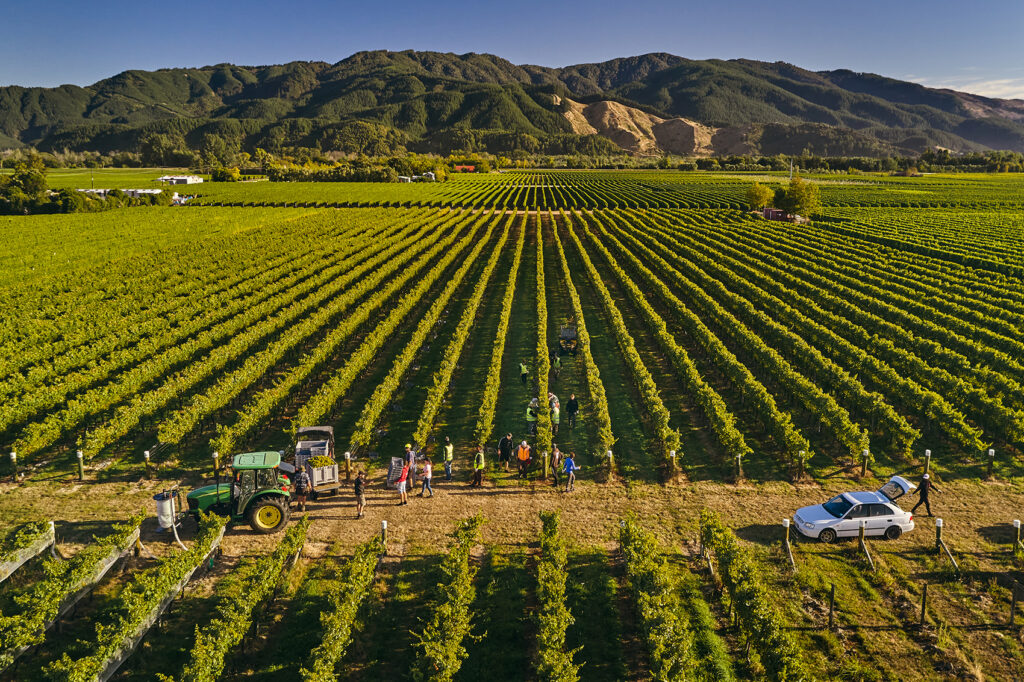
But back to your initial question – about Champagne, and I’d answer it in two parts. One – will anything challenge the brand of ‘Champagne’? Perhaps not. But, will the wine that we are capable of making in New Zealand – can that parallel the product of Champagne? I’ll answer you that by reading something. This was written in 2018 for Decanter by Elin McCoy
“You think you know New Zealand wine. Think again. Just before the annual Central Otago Pinot Noir Festival in January, I was dutifully working my way through an Air New Zealand Tasting in a boring Hotel Conference Room in Queenstown. When I was bowled over by a sparkling wine I’d never heard of before. The non-vintage No.1 Family Estate Reserve from Marlborough had the fresh, complex, salty, biscuity, rich finesse that you only find in Champagne. And very good Champagne at that.”
WF: But. Even if the product is seen to be as good – how do you climb that mountain that gets you on a level footing with the ‘aura’ of Champagne. Because I do believe that our sparkling product is as good as most Champagne product – certainly that the ones that most people would have come across. They’re fantastic.
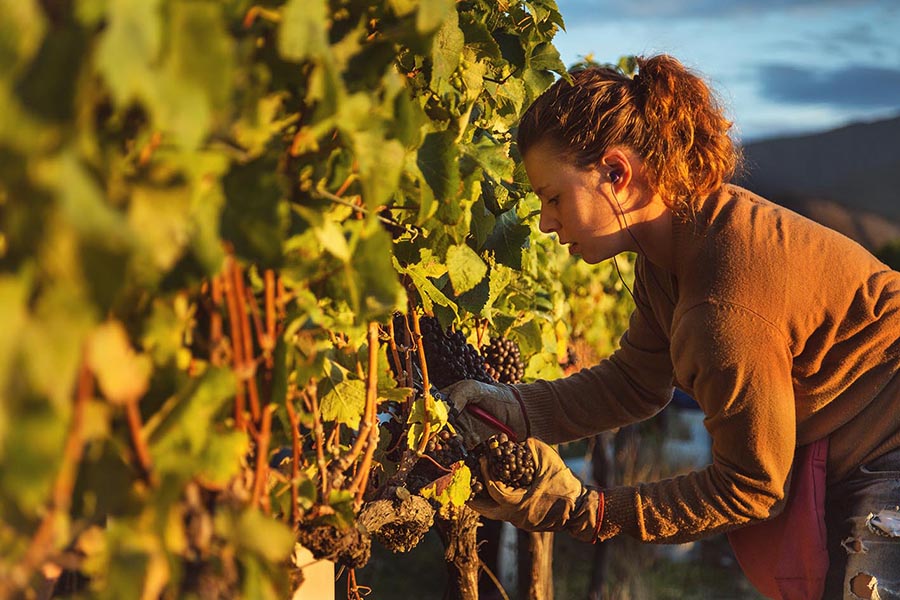
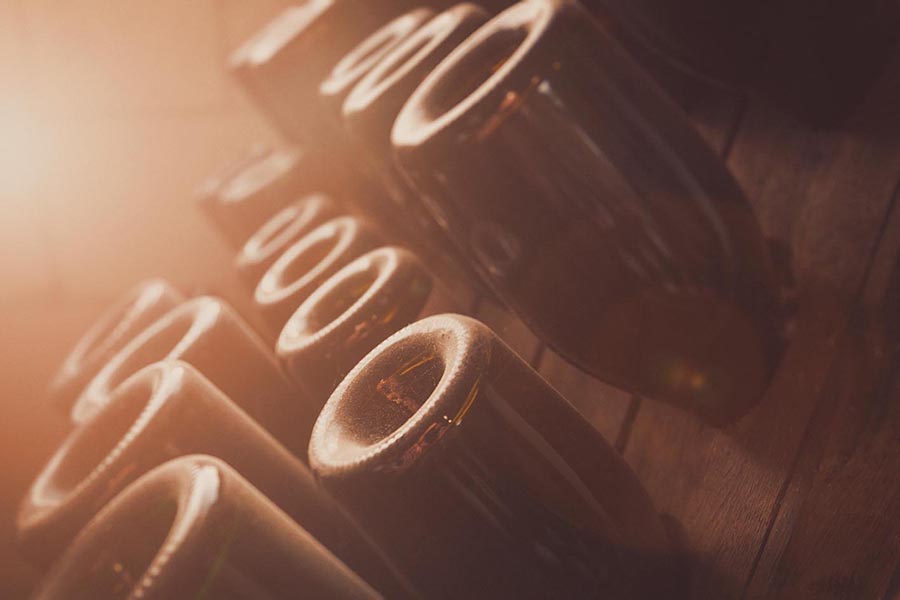
VLB: They are. They categorically are. And I’m so proud of the fact that there is so much out there from New Zealand. It’s wonderful. It’s not just a case of “I like mine better” and all that. The fact that someone is prepared to go the extra mile to make Methode.. I take my hat off to a producer, just for that! Because if you want to make a quick buck, Methode ain’t the way to do it (laughs)
WF: I thought it was interesting that you’ve got Marlborough as the region, and such a powerhouse of New Zealand wine. And then develop things like Methode Marlborough and now Appellation Marlborough.
VLB: Methode Marlborough. The tricky thing is it takes a long time and is costly to make Methode. I know we can turn Sauvignon Blanc round in a matter of months, and to me, to be honest, it’s still a challenge to see the vintage year that we’re still living in on a label of a wine bottle. But that’s just me. I know that Sauvignon Blanc has put us on the world stage. Wine can be quite contentious. There’s snobbery and all of that.
WF: Do you think there’s something about that that’s leading to the downturn in consumption? Do you think young people might look at wine as something that old people drink?
VLB: I don’t know, that’s a good question. Natural wines, for example, have been a wonderful way for people to find their way into wine drinking and appreciating different styles.
WF: Like the music that you liked as a young person and your parents didn’t, so it’s something just for you. “Dad hates this. Great. I love it”
VLB: Hahaha. Yes. And arguably a gateway. Maybe they’re just more discerning and other things are being considered. There’s not as much excess as there was for us previous generations. They’re living more consciously.
WF: And they do less of others things too. But then more. They do more protesting for example, which I think is great. I hope they are happier, because I look back on my childhood and think it was idyllic. Without mobile phones and connectivity and all that. Having children of my own, I do hope that they are happy. I hope they continue to drink wine, and sparkling wine of course!
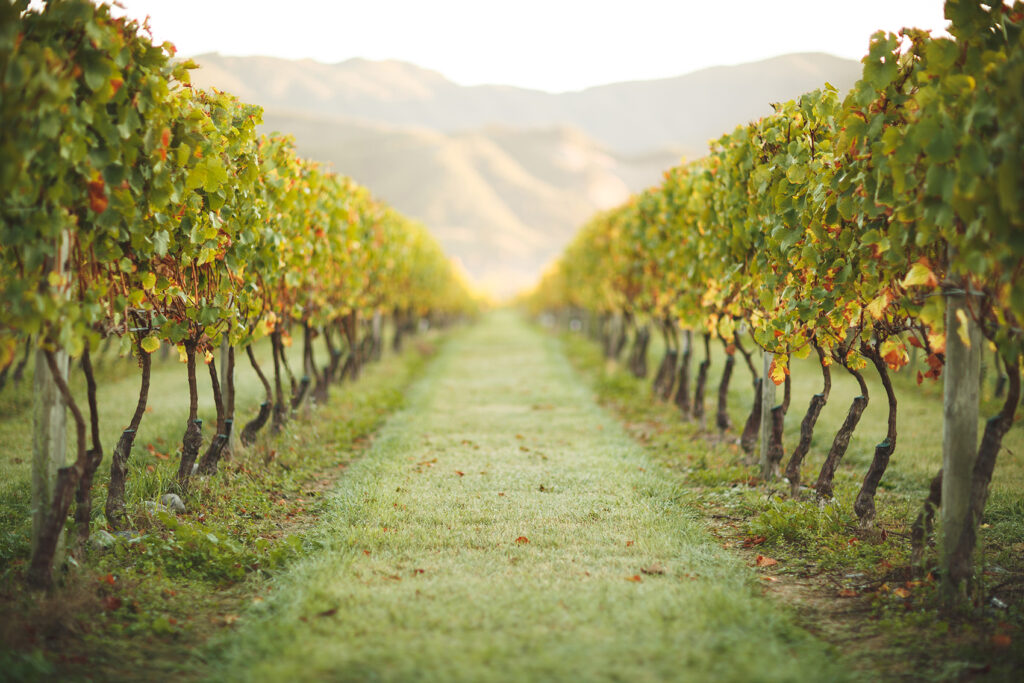
VLB: Certainly in the UK I found that it wasn’t even so much about celebrations – it was just a Friday!
WF: I like it for lunch I have to say. Because people often want to have rosé and I’m like ‘can’t we have some sparkling rosé then?’ And I don’t think that’s over the top. I love wine with food that makes the meal better, and a good sparkling wine is that, completely.
VLB: What we’ve found during COVID is that certainly there is an upswing in the interest around vintages, the Reserve, and the higher end. And people are keeping it local, so thinking of New Zealand which is great.
WF: Do you see a point where you may struggle to keep up with demand?
VLB: Well, if I keep selling like I am, then, yes. Turns out I’m really good at what I do!! That has absolutely been a silver lining to COVID. There’s wonderful support. It’s not even about selling wine – it’s about relationships and connections. I honestly never anticipated that I would have as much passion for what I do now. In truth it’s become more fulfilling and bringing me much more happiness than the stuff I used to do.

